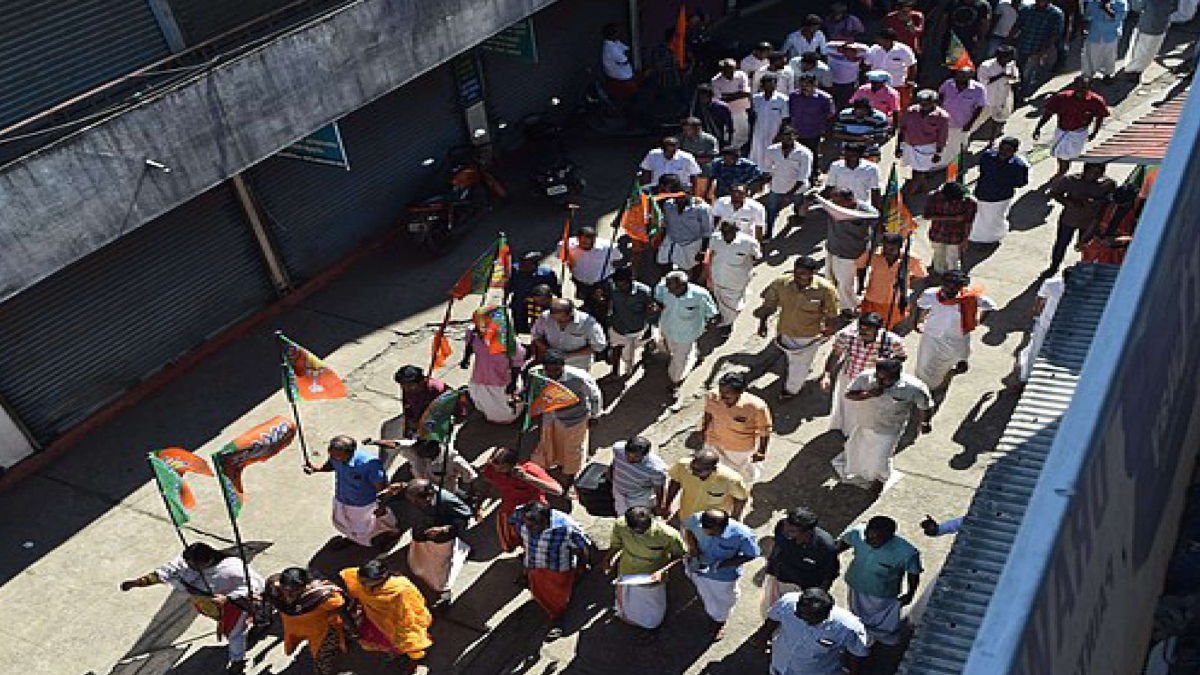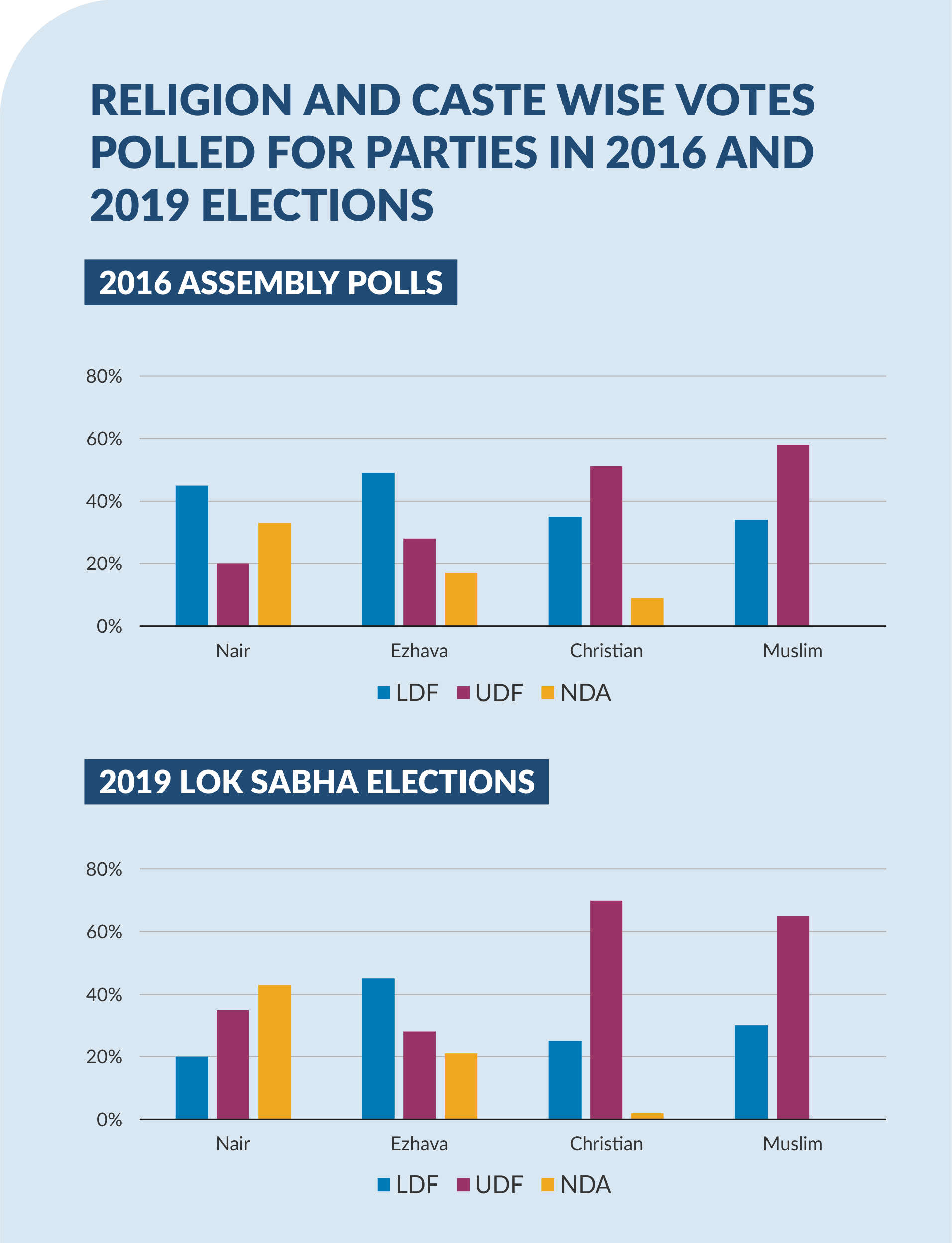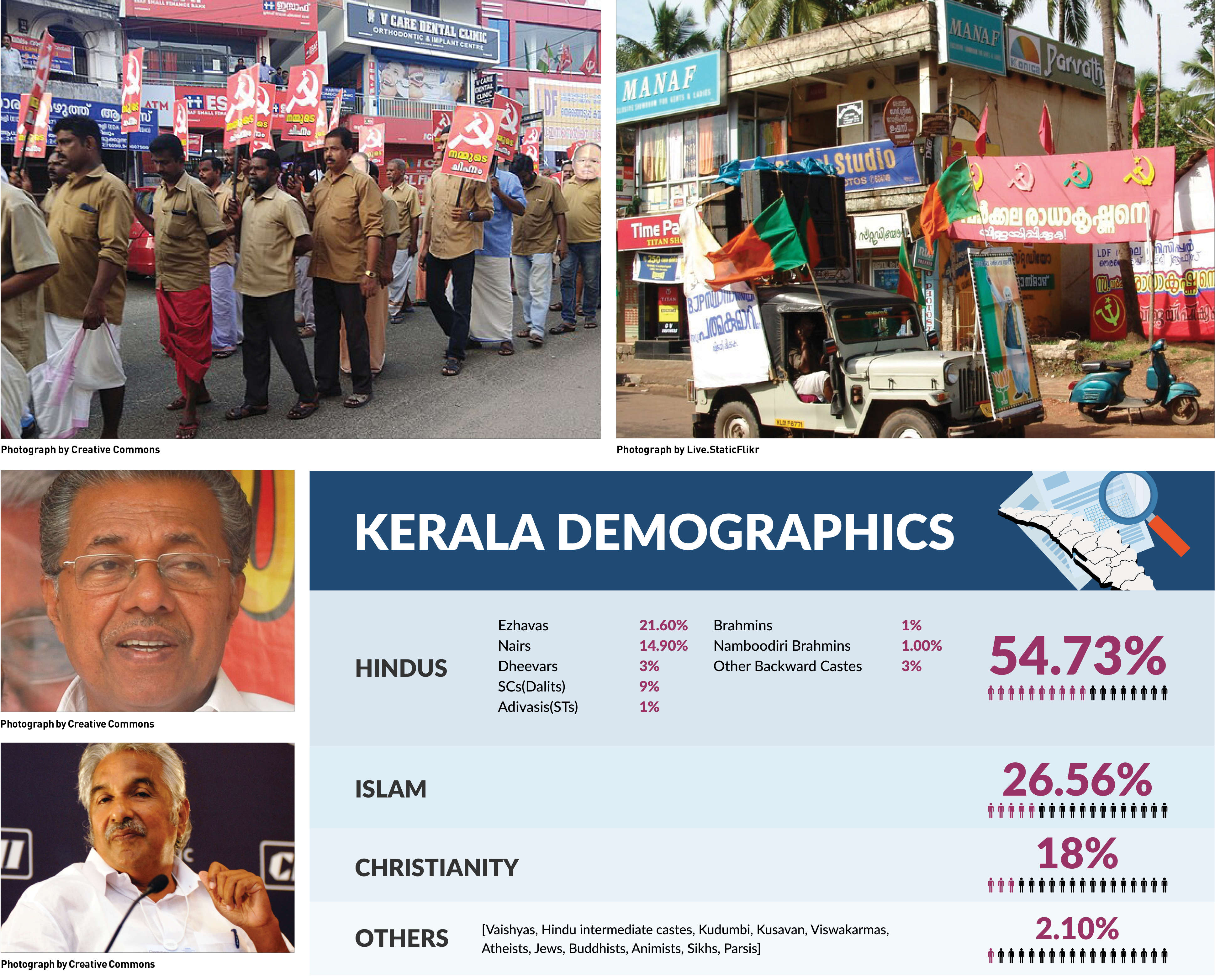


Voting for the Assembly Election in Kerala was held in one phase on April 6. The election was a two-pronged contest between the incumbent Communist Party of India (Marxist)-led Left Democratic Front (LDF) and Indian National Congress-led United Democratic Front (UDF). Traditionally, the state has never had the same government re-elected to power for two terms, and all eyes are on the incumbent LDF to see whether they will be able to break this pattern. In Kerala, unlike other states, the support of communities doesn’t always lean towards one party or alliance. Both the LDF and UDF have been able to secure votes across communities over the years, and in the past few years, the support of communities has shifted from one alliance to another. The Bharatiya Janata Party (BJP), however, in the state has relied mostly on votes of the Hindu community and to a small extent on the Christians. Let us explore more about the 4 most dominant communities in the state: Nair, Ezvaha, Christians, and Muslims to find out how support from these communities has shifted over the years and attempt to answer the question: who will they support in 2021?
NAIR COMMUNITY: SHIFT IN VOTING PATTERNS

Nair Hindus constitute roughly 15% of the population in Kerala and are dominant in Kollam, Kannur, Thiruvananthapuram and Pathanamthitta districts. As per the analysis of National and State Election Studies conducted by the Centre for the Study of Developing Societies (CSDS) and the Centre for Public Policy Research (CPPR), in the past 3 Assembly elections, the incumbent LDF has secured around 40-45% of Nair votes.
This figure drastically reduced to around 20% in the 2019 Lok Sabha election. Many analysts and experts attributed this sudden decline in support from the Nair community to the decision of the state government to implement the Supreme Court verdict allowing women of all age groups entry into the Ayyappa temple at Sabarimala. The UDF on the other hand had only managed to secure 20% of the votes of the Nair community in the 2016 Assembly elections, which was a considerable decline from 2011, where the UDF managed to secure around 43% of the votes. However, in 2019 during the Lok Sabha elections, the UDF managed to increase their vote share of the community to around 35%.
As per psychologists and election analysts, the vote share of the Nair community migrated mainly from the UDF to the BJP. The BJP-led National Democratic Alliance (NDA) had only managed to secure 33% of the votes of the Nair community in 2016 and managed to increase this to 43% in 2019 during the Lok Sabha elections. This is a dramatic increase from the past few elections when only 11% of Nair community members voted from the BJP (2006 and 2011).
Many have attributed this shift of the votes from the upper-class Nair community to the Modi Factor. The previous Assembly and Lok Sabha election both showcase that the BJP has benefitted from a shift in votes of the Nair community and as per experts is likely to happen in 2021 again.
EZHAVA COMMUNITY IN KERALA Photograph by Creative Commons
Photograph by Creative Commons Photograph by Live.StaticFlikr
Photograph by Live.StaticFlikr
Another dominant Hindu community in the state is the Ezhava community, which constitutes roughly 21.6% of the population. Ezhava community members have traditionally majorly voted for the LDF, which managed to secure around 64-65% of votes from the community in both 2006 and 2011 elections. However, this drastically fell to around 49% in 2016. The UDF, on the other hand, managed to secure around 26% of the votes from the community in the 2011 elections, and this improved slightly to 28% in 2016. Even in the 2019 Lok Sabha elections, the Ezhava community’s support for the UDF remained unchanged at 28%.
Once again, as in the case of the Nair community, the BJP, which only managed to secure 6-7% of the votes of the Ezhava community in both 2006 and 2011 elections managed to increase this to 17% in 2016. In the 2019 Lok Sabha elections, this number increased again, although only slightly to around 21%. As per the analysis of electoral trends conducted by the CSDS, the BJP used the narrative of ‘minority appeasement’ by the UDF to consolidate Hindu votes from Nair, Ezhava, Brahmin and SC communities. Another reason for the surge in Ezhava community votes towards the BJP could also be attributed to the work of its alliance partner Bharat Dharma Jana Sena which was established in 2015.
MUSLIMS IN KERALA: WHO WILL THEY SUPPORT?

Muslims in Kerala constitute roughly 26% of the population in the state. Traditionally, the Indian Union of Muslim League (IUML) has been influential in the Kozhikode, Malappuram, and Kasaragod districts of Kerala, where Muslim populations dominate. The IUML has been an alliance partner of the UDF for more than 40 years. The UDF managed to secure 65% of the votes from the Muslim community during the 2011 elections. This figure fell to 58% during the 2016 Assembly polls and increased back to 65% during the 2019 Lok Sabha elections. In the past 3 assembly elections, the LDF has been able to secure roughly 30-39% of the votes from the community.
This shift in Muslim voting trends during the 2019 LS elections occurred mainly owing to Rahul Gandhi’s rising prominence in the state. Congress-led UDF managed to even sweep out left citadels in Malabar, a result of the consolidation of Muslim votes in these areas. However, as per election analysts there seem to be no signs of a similar consolidation of Muslim votes in the ongoing assembly elections. Both the Rahul Gandhi and IUML factors which have helped the UDF secure minority votes in previous elections seem to be dimming out this time around. Another major factor behind this could be Chief Minister Pinarayi Vijayan-led LDF government’s strong stand against the Citizenship Amendment Act thereby having a positive impact on the minority population.
THE CHRISTIAN VOTE IN KERALA

Christians form roughly 18.4% of the 3.34 crore population of Kerala. While Catholics comprise the majority of the Christian population in the state, both Jacobite and Orthodox sects are also a small but influential part of the Christian vote. The community which is dominant in 33 seats could affect results in constituencies across Ernakulam, Kottayam, Idukki and Pathanamthitta districts. While traditionally Christians have supported the Congress, the past few years have seen attempts from both the incumbent LDF and the BJP to woo the community. Both the CPI(M) and BJP have been pushing for the narrative that the UDF is controlled by their alliance with the IUML in an attempt to influence Christian votes away from the UDF.
The UDF managed to secure 67% of the votes of the Christian community in the 2011 polls, however, this slipped to 51% during the 2016 Assembly polls. However, in the 2019 Lok Sabha elections, the UDF managed to increase its vote share in the Christian community again, securing 70% of the votes. The LDF, on the other hand, managed to decrease its vote share from the Christian community from 35% during the 2016 Assembly polls to only 25% during the 2019 Lok Sabha elections.
Another major factor that is likely to affect the vote of the Christian community in the state is the 2017 Supreme Court verdict which resulted in the control of several Jacobite churches in the state being handed over to the rival Orthodox faction. There have been widespread protests across the state by the Jacobite community who are concerned about the loss of their churches as a result of the implementation of the verdict.
The results of the 2021 Assembly elections will also show the impact of the split of the Kerala Congress (M), which is the largest Christian party in the state. For over 40 years, the KC(M) had been an ally of the INC-led UDF. However, the party’s official faction, led by the son of the party’s late Chairman, KM Mani has switched its alliance to the CPI(M)-led LDF. In fact, despite protests by party cadres, the CPI(M) has decided to give 13 seats to the KC(M), and is fielding candidates from the KC(M) from its strongholds such as Ranni in Pathanamthitta.
On the other hand, the rival KC(M) faction led by PJ Joseph has joined hands in alliance with UDF. While analysts expect the rival faction to secure 9-10 seats in Kottayam, Idukki and Pathanamthitta districts, the true impact of the split will only be visible once the results are out.